The barbell military press is a classic test of upper body strength and a powerful strength builder. At StrongFirst, we teach it on a foundation of our kettlebell skills. And while the principles (bracing, wedging, etc.) remain the same, tactics change to accommodate a different implement.
The double kettlebell press is ergonomically perfect. The barbell poses two challenges:
- Racking it without hyperextending your back.
- Getting it around your head.
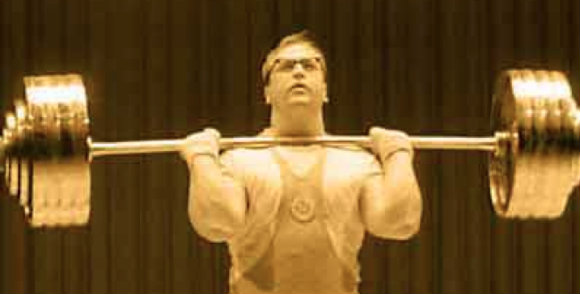
How to Protect Your Back in the Barbell Military Press
When the bar is heavy, there is no way to avoid extending your spine. If you do not, you will fail to position it over your feet and the barbell will simply fall in front of you.
The first thing you need to do to unload your back is extend your hips strongly—cramp your glutes and drive your pelvis forward. Just as in the kettlebell press, but more so. The more extended your hips are, the less the spine has to. It goes without saying that you need flexible hip flexors; something we address early on in our kettlebell curriculum.
The second move to spare your lower back is to extend your upper back. A flexible thoracic spine—something we hammer in our Kettlebell Courses and SFG Certs—not only will enable you to reduce the lumbar extension, it will make you stronger. You will be able to elevate your rib cage, pre-stretch your pecs, and provide a more stable support for the racked bar.
The Technique of the Barbell Military Press
Now for the tactics to get around your head. It all starts with the rack. Open and lift your chest. Tilt your head slightly back. Lift your chin and spread your shoulders. When you rack the bar, most of its weight should rest on the chest, rather than the arms. The chest is high, the back is taut, the glutes are cramped. Robert Roman, scientist and champion, warns that if your lower back and glutes are slack, the pressing effort will make your body “settle down” while the bar will stay in place. Only once the slack has been taken out of the body, the bar will move. Obviously, this is a waste of strength. So stay tight!
Soviet weightlifting authority Rodionov demonstrated that the lifter is at his strongest when he starts the press with the bar one to two inches below the clavicles. Presses with the bar right below the collarbones were weaker. Above the collarbones—weaker yet.
Push your elbows slightly forward and inward. This is the familiar-to-us “corkscrew” technique; the principles of strength are universal. Do not lift your elbows high because it will put your deltoids into a contracted position and you will have nothing to start the press with. Do not make the common these days mistake of copying the jerk or front rack. It offers no leverage to press heavy. For the strict press your elbows must be strictly under the bar or slightly in front of it, but never behind it.
It is very important to understand that the first half of a strict military press is essentially a front delt raise. Which means it is your elbows that should be driving the weight and not your hands. And this is the secret to passing your head smoothly.
The delts stop working when the upper arms are parallel to the deck. Triceps time. Instead of pushing the bar up, push yourself away from it, advises Olympic champion Arkady Vorobyev. Sounds familiar?—Yes, this is the “wedge” from our kettlebell system.
Press as close to your forehead as possible. When the bar is somewhat above your head, flare the elbows, push your head and shoulders under the bar and finish the press pushing slightly back.
Stand up victorious, a heavy weight overhead.
Yuri Vlasov Writes About the Press in Competition
Enjoy your press strength as two-time Olympian Yuri Vlasov did:
…I step out on the platform. Just behind me is my coach. In front—a large hall, silence, and the barbell. A record weight on the bar.
I adjust my singlet, my belt. I sniff ammonia from a cotton ball in my coach’s hand. I approach the barbell and try the bar… An excellent bar. The knurling cuts into the skin. It is sharp, not worn out by hands. We call such knurling “mea.” Like sandpaper, it ruthlessly rips the skin off the chest and the neck, leaving purple gashes. In return you get a death grip. The fingers will not open.
…I close my eyes and let my muscles go. The body hangs loose like a whip. I read my favorite poem. A ritual. It wakes me up and helps me gather myself “…To overcome yourself!”
To overcome yourself!
To overcome!
…The bar is on my chest. Air. I took a sip and froze. The muscles are locked. I shift the weight to my chest freeing the arms from the weight…The wrists are relaxed. The elbows are tucked against the body…Command! I grew into the effort. The bar has jumped off the chest and is on its way up. Ringing in my ears.
Humming of taut muscles. Like rumbling of bass strings.
To make it through the dead spot. The nastiest moment. One muscle group, shutting down, passes the effort to the next. And the next one is at an extremely unfavorable position and can’t not produce maximal power. The barbell could stop here and the fight could…end.
I press myself into the effort! Such a feeling as if I have pressed myself into some mold! And pressed in with full force. But I still keep compressing somehow!
…A scream fell like a wall of a tall building. People scream. The scream drives me on.
I am not surrendering. I am pushing with my arms with the last drop of strength left. My whole being is in the music. The bass strings roar at their limit—the most powerful muscles. The groan of small, tiny fibers joins them.
I am balancing with my torso. My feet are rocking in the shoes but the shoes are immobile. You may not lift them off the floor. Forbidden by the rules.
I am listening to the barbell overhead. Listening as one big ear.
To hold!
Sharp pain in the spine. As a kick with a boot.
Nothing around me but a jagged mottled spot. And from it—people’s scream. It holds me up. Makes me not listen to the pain and straightens out my arms all the way.
“Guee!”
“Yes!”—the ref’s voice.
Fatigue immediately fell on me as a huge wet bed sheet.
I was coming home…Excitation was dying out in waves. But I kept walking and walking. And the joy was impossible to suppress…
From an SFL student:
“Employing these techniques [learned at the StrongFirst Lifter certification] has helped me to:
1. Stop repetitive injuries that I was experiencing.
2. Allow me to push past any plateaus in strength I have had set two powerlifting national records.”
Get strong at an SFL Certification near you.
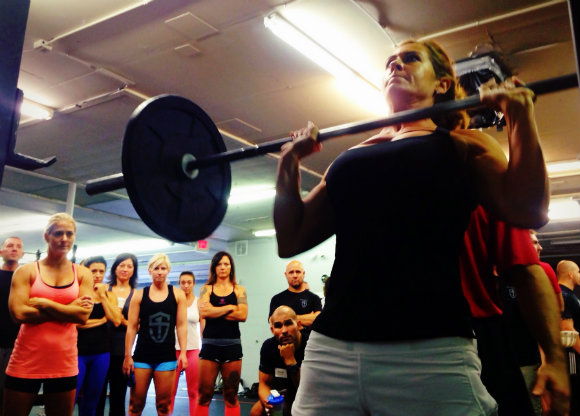
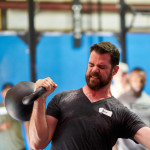
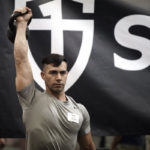
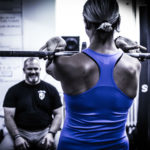


Thank you Pavel, excellent article. A quick question please. As I don’t currently have 44 & 48kg KB & I have a BB. Through utilising the principles of ‘same but different’, would a strict MP serve to prepare me for half bodyweight KBMP for SFG2?
Osu!
Dave, you still need to practice the groove of a KB press but if you have a 70-pounder for that and get strong with a barbell, it will work.
Thank you Pavel!
Thanks for the article! However, I was also expecting to clarify the lockout technique that is different from locking out kettlebell press- that means using upper traps to stabilize the weight (e.g. as taught by Mark Rippetoe).
Samorost, Russian weightlifters did not shrug on the top of the press and we do not teach it at SF either. we pack the shoulders. Same as with kettlebells.
Excellent as always, Pavel.
Pavel can you recommend a good training resource for cleaning the barbell for a military press?
Gary, a metal brush to get the chalk out if the knurling is sharp. An alcohol based solution to get blood and grease off.
Thank you for your kind words!
LOL thanks Pavel
Great article Pavel. Cleared up some technique questions I have. thank you It is amazing how kettlebells can get you ready for barbell training. Reneta and I were both amazed at our starting barbell strength when we began preparing for the SFL.
love your book , you great pavel tsatsouline in the future are you going to do more books , dvds about martial power?
Noe, lighten up or I will have you do a lot of swings ;]
Excellent, taking notes, thank you.
Military press (and deadlift) bring me pure joy of lifting something, from the ground up or overhead.
For all barbell military press fans, I have uploaded cool photo from my collection, Siegmund Klein’s Gym, 1957 – enjoy!
http://postimg.org/image/imowvnvn7/
great pavel